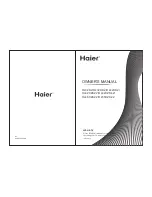
Circuit Descriptions, Abbreviation List, and IC Data Sheets
9.
9.14
CRT Panel / Rotation / Scavem (diagram F)
9.14.1
RGB Amplifiers
The integrated RGB amplifier (TDA6108, IC7307) is located on
the CRT panel. The cathodes of the picture tube are driven by
the outputs 9, 8, and 7.
9.14.2
Rotation (Diagram A5)
In sets with a rotation coil (wide screen sets), the amount of
frame rotation is adjusted with the 'TILT' DAC-output of the
HOP pin 25 (see 'Vertical Deflection').
9.14.3
Scavem
The Scavem-circuitry is implemented in the layout of the
picture tube panel. It is thus not an extra module. Scavem
means SCAn VElocity Modulation. This means that the picture
content influences the horizontal deflection. In an ideal square
wave, the sides are limited in slope by a limited bandwidth
(5 MHz).
Scavem will improve the slope as follows: At a positive slope,
a Scavem-current is generated, which supports the deflection
current. During the first half of the slope, the spot is accelerated
and the picture is darker, while at the second half of the slope,
the spot is delayed and the slope becomes steeper.
At the end of the slope, the Scavem-current decays to zero,
and the spot is at the original position. An overshoot occurs
which improves the impression of sharpness. At the negative
slope, the Scavem-current counteracts the deflection.
The Y-Scavem signal comes from diagram B4 and is the input-
signal for the Scavem-circuitry on the CRT-panel (it enters the
CRT-panel on pin 5 of connector 1940). The Y-Scavem
circuitry has: a RGB (2fH) input via the AV4-input, or a CVBS
input for the other signal sources.
Via TS7300 this signal is fed to emitter follower TS7304.The
signal is conveyed to the differentiator C2330, R3324, and
R3318. Only the high frequencies are differentiated (small RC-
time).
The positive and negative pulses of this signal drive TS7309/
7303 and TS7310/7302, respectively, into conductivity. The DC
setting of the output stage is set by R3421, R3423, R3424, and
R3426. The working voltage of the transistors is settled at half
the supply voltage.
At the positive section of the pulse, the current flows through
R3318, C2307, the Scavem-coil, and TS7309/7303. At the
negative section of the pulse, the current flows through R3318,
C2409, the Scavem-coil, and TS7310/7302.
9.15
Software Related Features
The following features are described:
•
Auto TV
•
'Switch On' Behavior
9.15.1
AutoTV
The AutoTV (or 'Automatic Picture Control' or 'Active Control')
aims at giving the customer the best possible picture
performance at any time. It is a collection of algorithms that
control the image processing parameters, depending on the
picture properties retrieved from meters or information in the
main software.
The following sub-systems are defined for AutoTV. They are
present or absent according to the hardware configuration of
the set.
•
Auto Noise Reduction. This algorithm measures the
amount of noise in the incoming video signal (this is done
by the LIMERIC part of the PICNIC). As a result of this
measurement, the amount of noise in the picture is
corrected, starting from the noise level that is unpleasant to
the customer. Which parameters can be used depends on
the hardware.
•
Auto Sharpness. This algorithm measures the amount of
sharpness via the bandwidth of the incoming video signal
and adapts the peaking frequency in the PICNIC according
to this info. If the 'sharpness meter' sees the video content
as 'sharp,' high frequency peaking will be used. If the
picture content is seen as 'not sharp,' a low/mid frequency
peaking is used.
Notes:
•
There is a coupling between the Auto Noise and the Auto
Sharpness algorithm: if noise is present in the video
content, then in general the sharpness will be made less
aggressive. Special care has to be taken to the interaction
of the LIMERIC and the vertical peaking of the PICNIC: an
overly large amount of vertical peaking increases the
visibility of the 2DNR artifacts.
•
Most algorithms are located in the embedded processor of
the PICNIC, because of time-critical calculations, and
because most picture analyzing and correction circuits are
present in the PICNIC. Some parts of the algorithms are
located in the main software, because the outcome needs
to be sent to other I
2
C devices.
9.15.2
'Switch On' Behavior
This is the start up sequence:
1.
After the power is applied, the 'Standby supply' starts
oscillating, generating the +5V2 (and +3V3). A reset (POR)
is generated and the Painter is awakened.
2.
Next step is the check whether the set needs to be in
'Standby' mode or not. Therefore, the NVM content is read
and the Standby-bit is checked. If the set is to stay in
Standby, there is no further action.
3.
If the set switches 'on', first the degaussing will be activated
(12 seconds).
4.
Meanwhile the MSP is reset and the Standby line is pulled
low, leading to a full semi standby mode (5 V and 8V
switched on).
5.
The Painter waits until the +5V and the +8 V are fully
present. Checking the AD-input of the Painter does this.
The +5V, +8V, and I
2
C protection-algorithms are activated.
6.
The HOP is instructed via the I
2
C-bus to start the drive.
7.
The main supply is activated via the SUP-ENABLE signal.
The Line Deflection circuitry is now supplied with the V
BAT
,
and the EHT generation can start.
8.
During start-up of the deflection, I
2
C traffic must be
disabled for 250 ms to avoid data corruption. If flashes or
spikes are generated during EHT start-up, I
2
C data could
be disturbed or corrupted.
9.
After deflection is powered up completely, all the other
protection-algorithms are activated.
10.
The black current stabilization loop in the HOP is switched
on. Some extra checking is done to ensure that the loops
are completely stabilized.
11.
The Painter sets all the necessary parameters for correct
sound and image and unblanks the picture.
Summary of Contents for Chassis EM1.1A AA
Page 51: ...Circuit Diagrams and PWB Layouts 51 EM1 1A AA 7 Layout LSP Top Side ...
Page 53: ...Circuit Diagrams and PWB Layouts 53 EM1 1A AA 7 Layout LSP Overview Bottom Side ...
Page 54: ...54 EM1 1A AA 7 Circuit Diagrams and PWB Layouts Layout LSP Part 1 Bottom Side ...
Page 55: ...Circuit Diagrams and PWB Layouts 55 EM1 1A AA 7 Layout LSP Part 2 Bottom Side ...
Page 56: ...56 EM1 1A AA 7 Circuit Diagrams and PWB Layouts Layout LSP Part 3 Bottom Side ...
Page 57: ...Circuit Diagrams and PWB Layouts 57 EM1 1A AA 7 Layout LSP Part 4 Bottom Side ...
Page 126: ...Revision List EN 126 EM1 1A AA 11 11 Revision List First release ...














































